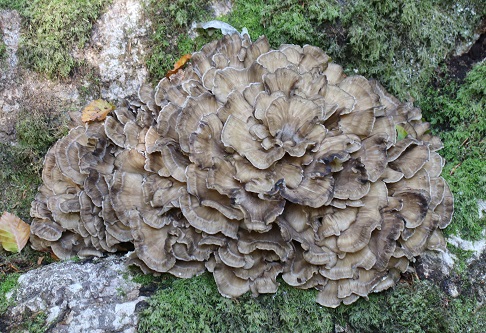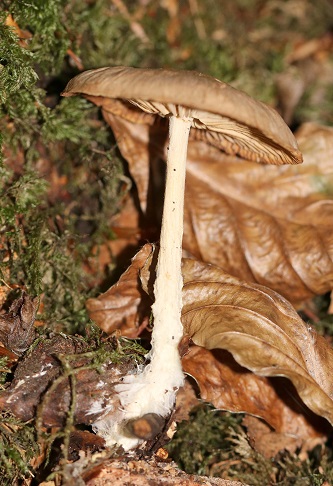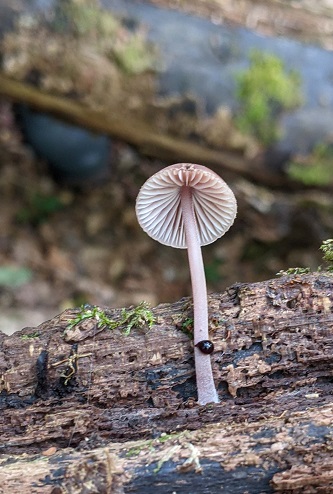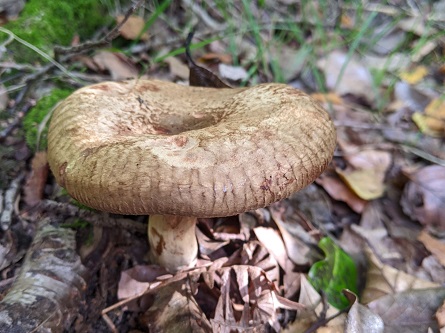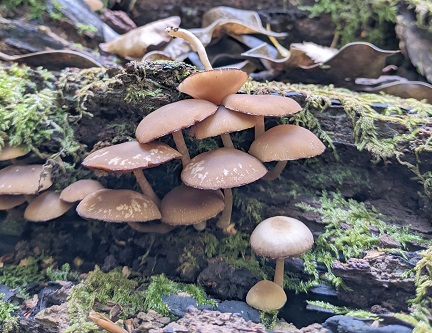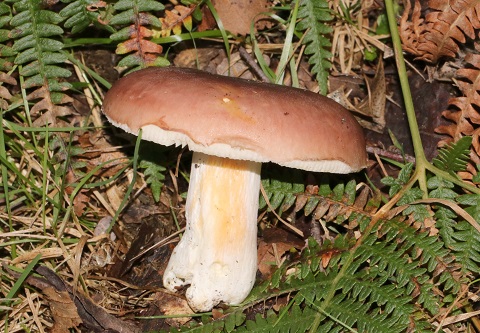Cadman's Pool
Sat 24 Sep 2022
Field event ID HF2213
Report: There was a good turn-out of members on a rather cool but dry and bright morning.
Shortly after entering the wood we came across a magnificent example of Grifola frondosa (Hen of the Woods), with another couple of fruiting bodies around the base of an oak. Boletes were still much in evidence though most were passed their best. These included Boletus appendiculatus (Oak Bolete), Boletus luridiformis (Scarletina Bolete), Leccinum aurantiacum (Orange Oak Bolete) and Boletus edulis (Cep).
There were plenty of fallen beeches to examine and the woody detritus soon produced Gymnopus peronatus (Wood Woollyfoot) and Polyporus squamosus (Dryad’s Saddle). In the surrounding soil we found Megacollybia platyphyllus (Whitelaced Shank) and two milkcaps, Lactarius blennius (Beech Milkcap) and L. subumbonatus (Watery Milkcap), the latter having a very dark cap and producing copious clear latex from the gills.
Collybia fusipes (Spindleshank) seemed much in evidence, as were Pleurotus ostreatus (Oyster Mushroom) and Oudemansiella mucida (Porcelain Fungus). Amongst the scattering of usual brittlegills which defy field identification using macro-characteristics, there was a nice example of Russula vesca (The Flirt) with a pink cap, the edge of which peels to reveal the white gills beneath.
Before breaking for lunch, we added Clitopilus prunulus (The Miller), Pholiota gummosa (Sticky Scalycap) and Mycena haematopus (Burgundydrop Bonnet).
In the afternoon session we found a large fallen beech which harboured several species including the bracket, Ganoderma resinaceum, Psathyrella piluliformis (Common Stump Brittlestem) and Calocera cornea (Small Stagshorn).
Not so much was seen on the walk back apart from some rather dried specimens of Laetiporus sulphureus (Chicken of the Woods) and a Paxillus involutus (Brown Rollrim) but two of the group found Sparassis crispa (Wood Cauliflower) under the pines next to the car park.
Species recorded: Amanita rubescens var. rubescens, Antrodia albida, Boletus appendiculatus, Boletus badius, Boletus edulis, Boletus luridiformis var. luridiformis, Bulgaria inquinans, Calocera cornea, Chlorociboria aeruginascens, Clitopilus prunulus, Conocybe rugosa, Coprinellus micaceus, Coprinopsis atramentaria, Cortinarius largus, Crepidotus cesatii, Crepidotus crocophyllus, Crepidotus mollis, Daedaleopsis confragosa, Datronia mollis, Fistulina hepatica, Fuscoporia ferrea, Ganoderma australe, Ganoderma resinaceum, Grifola frondosa, Gymnopus dryophilus, Gymnopus fusipes, Gymnopus peronatus, Hymenochaete rubiginosa, Inocybe curvipes, Inonotus cuticularis, Laccaria laccata, Lacrymaria lacrymabunda, Lactarius blennius, Lactarius quietus, Lactarius subumbonatus, Laetiporus sulphureus, Leccinum aurantiacum, Leccinum scabrum, Megacollybia platyphylla, Mycena filopes, Mycena haematopus, Oudemansiella mucida, Paxillus involutus, Phaeolus schweinitzii, Pholiota gummosa, Pleurotus ostreatus, Pluteus cervinus, Polyporus leptocephalus, Polyporus squamosus, Psathyrella piluliformis, Russula atropurpurea, Russula heterophylla, Russula nigricans, Russula poichilochroa , Russula pseudoaffinis, Russula silvestris, Russula vesca, Scleroderma verrucosum, Simocybe sumptuosa, Sparassis crispa, Stereum hirsutum, Trametes versicolor, Trechispora confinis, Trochila ilicina, Tubaria conspersa
A full species list with further details can be seen at the Fungal Records Database of Britain and Ireland (FRDBI). Please contact us if you need a user ID.

